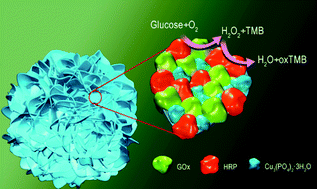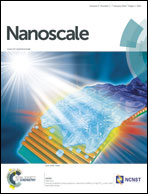Multi-enzyme co-embedded organic–inorganic hybrid nanoflowers: synthesis and application as a colorimetric sensor†
Abstract
This study reports a facile method for the synthesis of multi-enzyme co-embedded organic–inorganic hybrid nanoflowers, using glucose oxidase (GOx) and horseradish peroxidase (HRP) as the organic components, and Cu3(PO4)2·3H2O as the inorganic component. The synthesized nanoflowers enable the combination of a two-enzyme cascade reaction in one step, in which the GOx component of the nanoflowers oxidizes glucose to generate H2O2, which then reacts with the adjacent HRP component on the nanoflowers to oxidize the chromogenic substrates, resulting in an apparent color change. Given the close proximity of the two enzyme components in a single nanoflower, this novel sensor greatly reduces the diffusion and decomposition of H2O2, and greatly enhances the sensitivity of glucose detection. Thus, the obtained multi-enzyme co-embedded organic–inorganic hybrid nanoflowers can be unquestionably used as highly sensitive colorimetric sensors for the detection of glucose. Notably, this work presents a very facile route for the synthesis of multi-enzyme co-embedded nanomaterials for the simultaneous catalysis of multi-step cascade enzymatic reactions. Furthermore, it has great potential for application in biotechnology, and biomedical and environmental chemistry.


 Please wait while we load your content...
Please wait while we load your content...